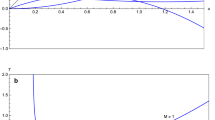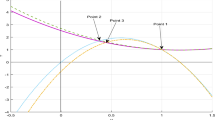Abstract
Specific features of shock wave interaction in a viscous heat-conducting gas with a low ratio of specific heats are numerically studied. The case of the Mach reflection of shock waves with a negative angle of the reflected wave with respect to the free-stream velocity vector is considered, and the influence of viscosity on the flow structure is analyzed. Various issues of nonuniqueness of the shock wave configuration for different Reynolds numbers are discussed. Depending on the initial conditions and Reynolds numbers, two different shock wave configurations may exist: regular configuration interacting with an expansion fan and Mach configuration. In the dual solution domain, a possibility of the transition from regular to the Mach reflection of shock waves is considered.
Similar content being viewed by others
References
E. Mach, Über den Verlauf von Funkenwellen in der Ebene und im Raume, Sitzungsber. Acad. Wiss. Wien, 1878, Vol. 78, S. 819–838.
J. von Neumann, Oblique reflection of shock waves, Explosive Research Report12, Navy Dept. Bureau of Ordonance, Washington DC. US Dept. Comm. Off. Tech. Serv. PB37079, 1943 (reproduced in Collected Works of J. von Neumann. Pergamon Press, 1963, Vol. 6, P. 238–299).
K. G. Guderley, The Theory of Transonic Flow (Translated from German by J. R. Moszynski), Pergamon Press, Oxford, New York, 1962.
H. Hornung, Regular and Mach reflection of shock waves, Annu. Rev. Fluid Mech., 1986, Vol. 180, P. 33–58.
G. Ben-Dor, Shock Wave Reflection Phenomena, Springer Verlag, New York, 1991.
H. Ogawa, S. Mölder, and R. Boyce, Effects of leading-edge truncation and stunting on drag and efficiency of Busemann intakes for axisymmetric scramjet engines, J. Fluid Sci. and Technology, 2013, Vol. 8, No. 2, P. 186–199.
Yu. P. Gounko and I. I. Mazhul, Numerical modeling of the conditions for realization of flow regimes in supersonic axisymmetric conical inlets of internal compression, Thermophysics and Aeromechanics, 2015, Vol. 22, No. 5, P. 545–558.
H. Hornung, H. Oertel, and R. Sandeman, Transition to Mach reflection of shock waves in steady and pseudosteady flows with and without relaxation, J. Fluid Mech., 1979, Vol. 90, P. 541–560.
M. S. Ivanov, S. F. Gimelshein, and A. E. Beylich, Hysteresis effect in stationary reflection of shock waves, Phys. Fluids, 1995, Vol. 7, P. 685–687.
M. S. Ivanov, G. Ben-Dor, T. Elperin, A. N. Kudryavtsev, and D. V. Khotyanovsky, The reflection of asymmetric shock waves in steady flows: a numerical investigation, J. Fluid Mech., 2002, Vol. 469, P. 71–87.
M. S. Ivanov, D. Vandromme, V. M. Fomin, A. N. Kudryavtsev, A. Hadjadj, and D. V. Khotyanovsky, Transition between regular and Mach reflection of shock waves: new numerical and experimental results, Shock Waves, 2001, Vol. 11, No. 3, P. 199–207.
A. Chpoun, D. Passerel, H. Li, and G. Ben-Dor, Reconsideration of oblique shock wave reflections in steady flows. Part 1. Experimental investigation, J. Fluid Mech., 1995, Vol. 301, P. 19–35.
M. S. Ivanov, A. N. Kudryavtsev, S. B. Nikiforov, D. V. Khotyanovsky, and A. A. Pavlov, Experiments on shock wave reflection transition and hysteresis in low-noise wind tunnel, Physics Fluids, 2003, Vol. 15, No. 6, P. 1807–1810.
D. Khotyanovsky, A. Kudryavtsev, M. Ivanov, B. Chanetz, A. Durand, M. Chernyshev, A. Omelchenko, and V. Uskov, Analytical, numerical and experimental investigation of shock wave reflection transition induced by variation of distance between wedges, West East High Speed Flowfield Conf., Marseille, France, April 22-26, 2002, P. 274–281.
D. V. Khotyanovsky, Y. A. Bondar, A. N. Kudryavtsev, G. V. Shoev, and M. S. Ivanov, Viscous effects in steady reflection of strong shock waves, AIAA J., 2009, Vol. 47, No. 5, P. 1263–1269.
E. I. Vasilev, A. N. Kraiko, Numerical simulation of weak shock diffraction over a wedge under the von Neumann paradox conditions, Comput. Math. Math. Phys., 1999, Vol. 39, No. 8, P. 1335–1345
M. S. Ivanov, Ye. A. Bondar, D. V. Khotyanovsky, A. N. Kudryavtsev, and G. V. Shoev, Viscosity effects on weak irrgular reflection of shock waves in steady flow, Progress in Aerospace Sci., 2010, Vol. 46, Nos. 2-3, P. 89–105.
A. Sakurai, M. Tsukamoto, D. Khotyanovsky, and M. Ivanov, The flow field near the triple point in steady shock reflection, Shock Waves, 2011, Vol. 21, No. 3, P. 267–272.
S. A. Gavrenkov and L. G. Gvozdeva, Formation of triple shock configurations with negative reflection angle in steady flows, Technical Physics Letters, 2012, Vol. 38, Is. 4, P. 372–374.
S. A. Gavrenkov and L. G. Gvozdeva, Numerical investigation of the onset of instability of triple shock configurations in steady supersonic gas flows, Technical Physics Letters, 2012, Vol. 38, Is. 6, P. 587–589.
M. S. Liou and C. J. Steffen, A new flux splitting scheme, J. Comput. Phys., 1993, Vol. 107, No. 1, P. 23–39.
H. G. Hornung and M. L. Robinson, Transition from regular to Mach reflection of shock wave. Part 2. The steady-flow criterion, J. Fluid Mech., 1982, Vol. 123, P. 155–164.
E. Martelli, B. Betti, F. Nasuti, and M. Onofri, Effect of the abiabatic index on the shock reflection in overexpanded nozzle flow, Program and abstracts, Intern. Symp. on Shock Waves, Tel Aviv, Israel, July 19-24, 2015, P. 166–168.
D. V. Khotyanovsky, A. N. Kudryavtsev, and M. S. Ivanov, Effects of a single-pulse energy deposition on steady shock wave reflection, Shock Waves, 2006, Vol. 15, No. 5, P. 353–362.
A. N. Kudryavtsev, D. V. Khotyanovsky, M. S. Ivanov, A. Hadjadj, and D. Vandromme, Numerical investigations of transition between regular and Mach reflections caused by free-stream disturbances, Shock Waves, 2002, Vol. 12, No. 2, P. 157–165.
Author information
Authors and Affiliations
Corresponding author
Additional information
This work was supported by the Russian Foundation for Basic Research (Grant Nos. 15-58-52044 and 14-08-01252). Numerical simulations were performed on clusters of the Siberian Supercomputer Center of the Siberian Branch of the Russian Academy of Sciences and Novosibirsk State University.
Rights and permissions
About this article
Cite this article
Shoev, G.V., Ivanov, M.S. Numerical study of shock wave interaction in steady flows of a viscous heat-conducting gas with a low ratio of specific heats. Thermophys. Aeromech. 23, 343–354 (2016). https://doi.org/10.1134/S0869864316030045
Received:
Revised:
Published:
Issue Date:
DOI: https://doi.org/10.1134/S0869864316030045




